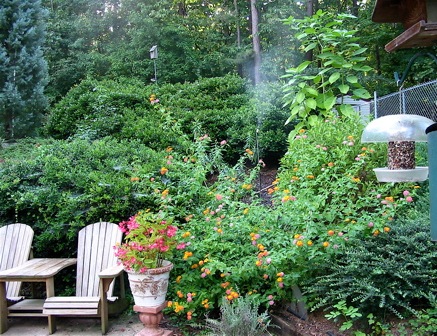- Bird Houses, Blue Bird Houses, Bluebird Houses, Uncategorized, Unique Birdhouses, Vinyl with Copper Roof Birdhouses
bluebird houses crafted in vinyl last a lifetime!
Here in this southeastern back yard, the Bluebirds never left, they over-wintered as our accommodations provided them well through a frigid winter season. Live mealworms were (and still are) fed daily, and bird baths remained heated throughout winter months. Lots of roosting spots, including several bluebird houses helped them keep warm at night.
Although wood is always good for most bird houses, over time it tends to weather and rot… which is not so good for prospective tenants. On the other hand, vinyl houses (like the kind people live in) pretty much last forever.
There’s a new breed of bluebird houses crafted to do just that… last forever! Architectural Bluebird Houses in white vinyl are an attractive and affordable alternative if replacing old nest boxes. Since they’re hand made (in the USA) there’s always a color choice for the roof too. Exterior grade plywood is covered in a coated aluminum to provide durability beyond compare. Roofs are available in bronze (shown here), verdigris and hammered copper options. With meticulous construction, and inert materials, these vinyl bluebird houses will last a lifetime, hosting many successful broods over the years.
One other thing on bluebird houses: as a rule of thumb, houses should be placed in open areas, at least one hundred feet apart, as bluebirds are
quite territorial. But if there is competition from swallows or other birds for the same house, placing another nest box about ten to fifteen feet apart will in many cases, make both parties happy!
- Bird Accessories, Bird Feeders, Bird Nesting Materials, Hummingbird Feeders, Nesting Material, Uncategorized, Window Hummingbird Feeder
add this near your window hummingbird feeder
With the hummingbird migration in full swing, it won’t be long before the tiny sprites are in your neck of the woods. Already spotted in LA, SC, TX and all along the Gulf Coast, its just a few short weeks before they’ll infiltrate up the East Coast and Midwest, ultimately reaching Alaska, British Columbia and Canada.
Aside from your hanging or window hummingbird feeder, you can further entice hummers with moving water such as birdbath fountains and bubblers, and of course, nesting material.
The Hummer Helper nesting material has been tested and proven to increase the numbers and activity of hummingbirds at your feeders. How you might ask? Because if suitable nest sites are found in your yard, juveniles will also visit feeders, including your window hummingbird feeder. If nectar is always kept fresh, and there’s an enticing water feature, you can bet the same hummingbirds will be back next year! They’re known to practice “site fidelity” meaning that attractive diggs will remain their site of choice the following year. Hummer Helper Nesting Material has even been endorsed by The Hummingbird Society for its effectiveness at promoting nesting by hummingbirds.
Hummingbirds aren’t the only ones who will use this nesting material either, American Goldfinches also adore the white fluffy stuff and will use it for their nesting season in late June through July.
Encourage nesting in your yard through wildlife-friendly habitat. Food water and shelter are the keys, whether natural or man-made. Nectar-producing flowers provide food, while shrubs help with predator protection and provide nesting spots, these will attract many species of wild birds. Water is the best way to attract even more feathered friends too. Mature trees, fruit or berry-producing trees, and even brush piles serve many wild birds well. Never throw out or burn garden debris, if space allows, use it to create brush piles in the back of the yard… your wildlife will thank you for this valuable and natural cover!
-
Time to Dust Off those hummingbird feeders
The great hummingbird migration has begun!
Now is the time to get your hummingbird feeders out from storage and give them a good cleaning for the upcoming season. Plain hot water works, even if you send them through the dishwater, be sure to rinse them thoroughly to remove any residue. Along the Gulf of Mexico, Ruby Throats have started to claim territories, with other species following close behind.
Hummingbird season is an exciting one for many backyard birders, as these little sprites tend to provide some mesmerizing entertainment. Many folks could just sit and watch hummingbirds’ shenanigans for hours on end. Aside from the sugar water in hummingbird feeders, moving water is a very big attraction for them. Bathing, drinking and playing in birdbath fountains or bubblers comes naturally for hummers – they’re drawn to it like a magnet.
If you’re looking to attract more hummers, but already have enough hummingbird feeders, consider adding moving water to your landscape. Leaf misters for instance, are wildly popular among hummingbirds and butterflies as well. In the scolding heat of summer, the gentle mist is a most welcomed addition for many local wildlife species. Leaf misters may be installed in a variety of fashions. Ours stands upright in the garden twisted around a simple plant stake.
Treat your hummingbirds to a fun water feature this season and you’ll be rewarded by increased numbers and some fascinating activity and behaviors from the little guys!
Oh yeah… maybe this is the season to try making your own nectar too. It’s really quite simple and only takes a few minutes. Here’s the recipe: one part plain table sugar (cane) to four parts water. That’s it! Never use anything other than pure cane sugar (white table sugar) as it’s harmful to hummingbirds. There’s really no need to boil the water, we boil one cup simply to dissolve the sugar quicker and more effectively. If you do boil the water, be sure it has cooled before filling your hummingbird feeders. Store extra nectar in the fridge for up to two weeks. Now wasn’t that easy?






